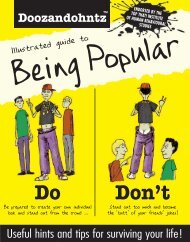desert bugs - Top That! Publishing
desert bugs - Top That! Publishing
desert bugs - Top That! Publishing
You also want an ePaper? Increase the reach of your titles
YUMPU automatically turns print PDFs into web optimized ePapers that Google loves.
Why do bees and wasps sting<br />
The yellow and black colours of bees and wasps act as a warning to say that<br />
these insects sting! While a sting can be painful and, in a few people, cause a<br />
serious allergic reaction, bees and wasps usually attack only when they feel<br />
threatened. A bee can sting only once. This is because a little hook on the end<br />
of its stinger catches in whatever it decides to sting, causing its abdomen to tear<br />
as it flies away. The bee dies as a result. Wasps, on the other hand, can sting many times.<br />
How can I avoid being stung<br />
Not every bee or wasp is out to sting you. Remember,<br />
they usually attack only when they feel threatened, and<br />
this might be because you are standing too close to<br />
their nest (you may not even realise it). If a wasp or<br />
bee comes closer to you than you’d like, just walk<br />
away calmly. If you wave your arms about and start to<br />
panic, you’ll probably just convince it that you really<br />
are a threat.<br />
Why do wasps like picnics<br />
Wasps love sugary foods, so a picnic for you is a<br />
picnic for them too! Throughout the summer they are<br />
busy feeding their young, so don’t tend to bother<br />
people, but by the end of the season they are at their<br />
most annoying as they search for their favourite<br />
sugary snacks (such as ice creams, fizzy drinks and<br />
fruit). If you prepare a separate picnic for the wasps<br />
– perhaps a plate of sweet, sticky jam or a bottle of<br />
cola – and put it at a safe distance, they can join in<br />
without upsetting your fun. Remember, though,<br />
always look out for them before you sit down, put<br />
your hands down or take a bite of your picnic lunch.<br />
22<br />
What do wasps eat<br />
Yellow<br />
and black<br />
warn that<br />
this insect<br />
stings!<br />
Wasps usually eat insects, including caterpillars, ants<br />
and flies. They also feed on household waste and on<br />
the bodies of dead animals. There is one type of<br />
wasp, the tarantula hawk wasp, whose larvae feed on<br />
tarantula spiders. The female wasp watches, waits and<br />
pounces on a tarantula, paralysing it with her sting.<br />
Once her wasp grub has hatched, it sucks the juices<br />
from the still-living, but paralysed, spider!<br />
Wasps love the sweet<br />
taste of fruit.





